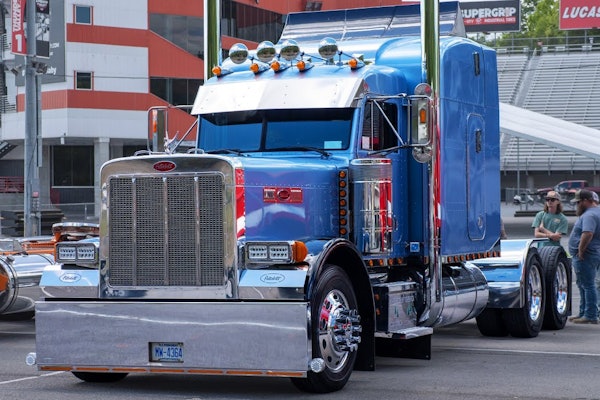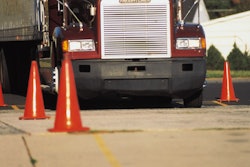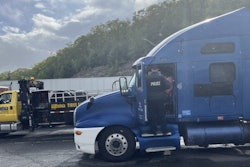On the skids
Knowing what to do before your truck starts sliding may help you avoid a serious crash
The skid you drive away from is often the road situation you avoid in the first place. Stephen Adams, a driver for May Trucking, says, “Develop a defensive driving routine, because what doesn’t seem like a bad habit under normal driving conditions is life-threatening when the weather gets bad. You’ll be prepared for whatever’s in front of you.”
Terry Braginton, lead instructor for the Michigan Center for Decision Driving, says you can’t always avoid every potential skidding situation, but you can control your response. “If you have to hit something, make it a controlled crash,” he says, preferably away from other vehicles.
Skid control covers an eight-hour day in the MCDD driver-training program. The training begins with teaching a driver how to stop through threshold braking, which results in tires gaining maximum traction on the road surface. “We start there because guys who’ve been on the road for 30 years have been taught to pump and stab the brakes,” Braginton says. “The problem is, the closer you get to what you’re looking at and trying to stop, the more excited you get; and the more excited you get, the more brake pressure you put on the system. You end up with locked wheels. Locked wheels lead.”

In any kind of skid, Braginton says to keep your heel on the floor and use your toes to push on the brake. No matter the type of skid, the goal is to keep the wheels rolling. Put in the clutch and separate the power from the drive.
If the truck’s steer tires are turned past 15 degrees, you’ll experience a front-wheel skid: The tire treads have lost control with the road and are “pushed together,” he says. “You’re trying to climb the sidewalls.”
In a trailer jackknife, Braginton says some drivers pull the hand valve, which applies more braking pressure on the trailer. Your aim is to get the trailer wheels rolling again. Maintain steady fuel and “drive it out,” he says. The trailer will continue skidding until the air is exhausted from the brakes and the wheels begin turning again. “Don’t turn into the trailer or you’re going to meet your maker,” he says. Instead, turn away from the trailer.
Other drivers might try to ease off the fuel in the false belief that the tractor is skidding, or try to run from the trailer by applying extra fuel. “They overpower the wheels and create a jackknife on the tractor and trailer,” Braginton says. “When you overpower the drive tires on the tractor, the trailer will pull the truck out from under you. When the tractor digs in and stops, the trailer has to go somewhere. When it comes around, it comes around hard.”
The solution: Recognize your problem as locked wheels, and get your wheels rolling. Remove your foot from the brake, maintain steady fuel, and focus on a target down the road and drive toward it.
Oversteering
Adams, who teaches about defensive driving and skid control, says oversteering is like fishtailing in your car. Your front wheels take a shorter path than desired, your rear end breaks out, and your drive axle loses traction.
To correct, get off the accelerator and keep your foot off the brake. If driving standard shift, disengage the clutch. If driving automatic, put it in neutral. If you’re using cruise control, take it off, because it applies too much acceleration and you lose traction. Turn the vehicle back in a safe direction to finish the correction.
Understeering
In understeering, your steering is too much for the power you’re applying and your steer tires have lost traction. Your steering wheel is turned at too sharp an angle as you’re applying too much power. “Slow down and reduce that angle of steering,” Adams says.
Weather Conditions
While slippery road conditions caused by ice and snow or oil are similar, hydroplaning caused by rain creates its own set of problems. Your tires are built to dissipate water, and when water on the road is too deep, you lose traction.
Adams says to check your tires for even treadwear and sufficient tread depth for the terrain and weather conditions where you are driving. Make sure your tires are properly inflated. Also note that the heavier your rig is, the less likely it is to hydroplane.
Technology helps combat skids
Technology exists to help a driver avoid losing control in a skid. Stability systems act as an invisible hand to assist the driver out of a potentially dangerous situation.
Stability systems come in two types: full stability (electronic stability control, or ESC) and roll stability (roll control stability, or RSC). Both have lateral acceleration sensors that measure the side-to-side motion of a vehicle, such as when a truck takes a turn too fast.
Beyond that, the ESC system incorporates steer-angle sensors to read the driver’s actions and yaw, or directional, sensors that relay where the vehicle is going, says Fred Andersky, director of government affairs at Bendix. “The full stability system takes readings and reacts sooner than a roll-only system to help the driver,” he says.
When the system recognizes trouble, it cuts the throttle first and then applies brakes on the steer, drive and trailer axles. “If you don’t arrest the skid early, it becomes harder and harder to recover as it develops,” says Rick Conklin, product manager of stability control at Bendix.
The National Highway Traffic Safety Administration is considering a stability system mandate for tractor-trailers and motor coaches. Andersky anticipates a proposed rule by the end of the year.
TIPS
Terry Braginton and Stephen Adams offer these tips for reducing your odds of getting caught in a tight situation that could lead to skidding:
• Slow down: reduces stress level, cuts fuel consumption
• Keep safe following distance of 12-15 seconds: Stay out of the path of unpredictable four-wheeler maneuvers.
• Maintain clean windshield: helps reduce eye fatigue
• Progressive shift: Keep your RPMs low.
• Don’t pass on a bridge: surface may be slick
• Don’t pass on a corner: Road conditions ahead are out of sight.
Steering like NASCAR drivers
Shuffle steering is a technique used by NASCAR drivers and is taught at driving training schools to help maintain vehicle control. The notion is this technique will create more precise steering and more accurate skid control:
Your left hand is always on the left side of the steering wheel and your right hand on the right side. One steering version allows you to position your hands in various positions, while another school has you place your hands at the same height. Before a turn, your hand positions mirror each other for example, left hand at 9 o’clock and right hand at 3 o’clock. The highest both hands can be is at 12 o’clock and the lowest is at 6 o’clock.
Your hands never leave the wheel and never cross each other. In a turn, one hand grips the wheel and pulls the wheel in the direction of the turn, while the other slides on the wheel. In a stationary position, both hands are gripping the wheel.







